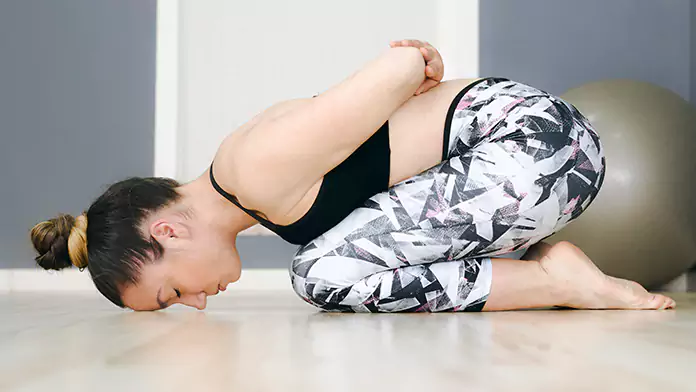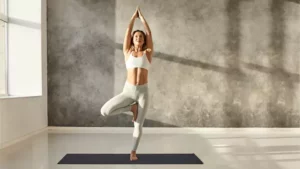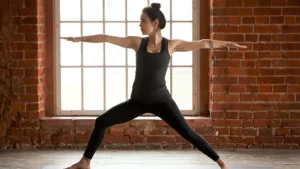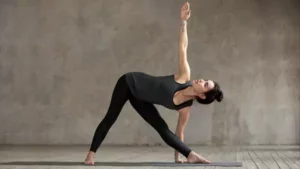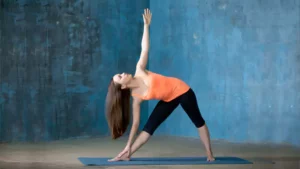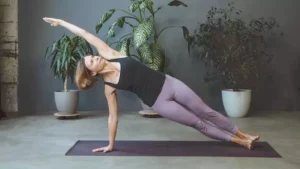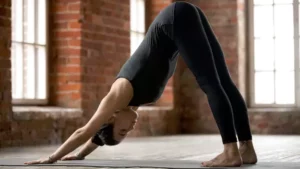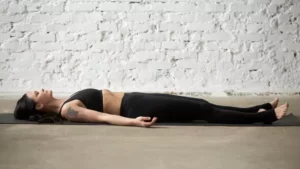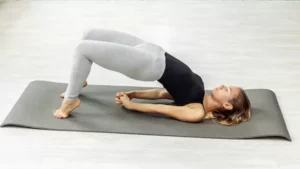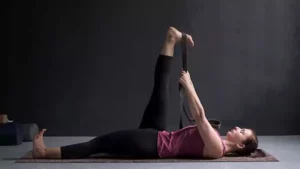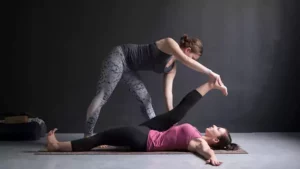Did you know that around 18% of the world’s population suffers from osteoporosis? It is a condition that involves the gradual deterioration of the bone tissues, making the bones weaker and more prone to damage and fractures.
Since the condition directly affects and alters bone mass, exercises in varying forms and intensities are quite effective in handling the symptoms and preventing their onset in individuals. Yoga is a universal form of exercise that imposes versatile benefits.
Not only does it improve agility, but it also strengthens the bones and prevents risks of fractures and bone damage that are most commonly associated with osteoporosis. This article will explore some of the best yoga for bone health you can start doing today for the prevention of osteoporosis.
In this Article
- 1 What is Osteoporosis?
- 2 How does Yoga Benefit Osteoporosis?
- 2.1 What are the Best Yoga Poses for Osteoporosis?
- 2.2 1. Vrksasana or Tree Pose
- 2.3 2. Virabhadrasana II — Warrior II
- 2.4 3. Trikonasana — Triangle
- 2.5 4. Parivrtta Trikonasana — Twisted Triangle
- 2.6 5. High Plank Pose
- 2.7 6. Adho Mukha Svanasana (Downward-facing dog)
- 2.8 7. Corpse Pose or Savasana
- 2.9 8. Setu Bandhasana — Bridge
- 2.10 9. Supta Padangusthasana II — Supine Hand-to-Foot II
- 2.11 10. Supta Padangusthasana I — Supine Hand-to-Foot I
- 2.12 FAQs
- 2.13 Conclusion
What is Osteoporosis?
Osteoporosis is a progressive bone condition that involves the deterioration of the bone by making them more porous than normal. Even under normal conditions, our bones have a natural sponge-like structure, which allows easy absorption of nutrients (especially calcium).
In patients with osteoporosis, the holes in the bones increase, making the bones feel a lot more hollow and more porous. This happens due to reduced bone mass in an individual.
Such patients are at heightened risk of developing fractures, especially in the more sensitive areas of the body, including hips, spine, knees, etc.
While lifestyle changes, proper diet, supplementation, etc., can help manage the disease, studies indicate that indulging in the right exercises can support and build bone mass to compensate for the depleting levels of calcium.
How does Yoga Benefit Osteoporosis?
When you think of yoga, you think about its benefits in weight loss and promoting energy levels. We generally don’t correlate the benefits of yoga asanas with bone disorders, especially osteoporosis.
A patient with osteoporosis is at heightened risk of sustaining fractures, even on the slightest bump and fall. Indulging in the right yoga postures can improve one’s balance, gait, and posture, thereby preventing these potential risks.
A few different types of yoga poses involve “weight bearing movement,” which studies have shown is effective for bone formation and enhances the strength of the bones. Research suggests that individuals who engage in yoga have better bone mineral density, which is crucial for osteoporosis management.
Yoga for bone density is also crucial in post-menopausal women, who are more susceptible to bone loss. The primary reason behind the depletion of bone health in women is the reduced estrogen levels in the body. Women are hence advised to engage in yoga to reduce the risks of bone loss and depleting bone health.
It is true that more peer-reviewed and conclusive studies are necessary to determine how yoga helps in retaining bone density and helping patients manage osteoporosis symptoms.
What are the Best Yoga Poses for Osteoporosis?
There are multiple yoga exercises for osteoporosis, most of which help restore bone density, improve posture and balance and strengthen the bones in the body.
Some of the most important and effective ones include:
1. Vrksasana or Tree Pose
Targets: Ankles, knees, spine, calves, glutes, hamstrings, and lower back muscles.
Benefits: Improve stability, balance, and posture; Strengthens ligaments and muscles; Improves pelvic stability.
How to do it?
- Stand with your spine straight and keep the feet hip-width apart.
- As you put your balance and weight on the right leg, lift your left foot and bend it at the knee.
- Bring your left foot’s underside (sole) and place it on your ankle or the inner side of your thigh.
- Raise your arms above your head and join your palms.
- Look straight ahead and hold this pose for 5-10 seconds.
As you lower your left leg, exhale and inhale again. Repeat the same with the right foot too. It is an effective asana for bone health improvement.
2. Virabhadrasana II — Warrior II
Targets: Legs, core muscles, gluteal muscles, hamstrings.
Benefits: Improves balance; Boosts core strength; Strengthens shoulder and back muscles.
How to do it?
- Lay a yoga mat on the ground and stand on top of it.
- Keep your feet parallel while facing toward the room’s left side.
- As you turn your right foot towards the front of the mat, simultaneously bend your right knee to form a 90-degree angle with the ground.
- Raise your arms until they reach shoulder level.
- Hold this posture for 30 seconds and return to the initial position.
- Repeat this yoga again for 5-10 repetitions for better results.
3. Trikonasana — Triangle
Targets: Hamstrings, hips, groin, chest
Benefits: Improves balance and stability; Stretches the spine; Opens the shoulders and hips
How to do it?
- Lay your yoga mat on the ground and stand on top of it, keeping your leg wide open.
- While you keep your left foot facing front, turn the right foot at a 45-degree angle towards the right.
- Bend your hip, inclining it towards the right foot as you bring your arm down the side of the thigh, eventually touching the ground. If you can’t bend enough to touch the ground, bend as much as you can.
- Keep your left arm extended above your head.
- Hold this position for 20-30 seconds. Once done, repeat the same on the other side.
This is one of the best yoga poses for strengthening your core muscles and improving flexibility, which might be compromised if you have osteoporosis.
4. Parivrtta Trikonasana — Twisted Triangle
Targets: Glutes, hip flexors, hamstrings, spine, calves, middle back, quadriceps.
Benefits: Increases stability; Stretches the hips and spine; Stimulates the organs.
How to do it?
- Stand with a wide stance on your yoga mat and turn the right foot towards the front of the yoga mat.
- While keeping your hands on your hips, gradually turn your torso towards your front leg.
- Put your left hand right below your left shoulder for added support.
- Raise your right hand above your head and in the air and hold it there.
- Hold this stance for 20-30 seconds.
- Repeat the same posture on the other side for 5-10 rounds or less, depending on how much you can take.
5. High Plank Pose
Targets: Abdominals, wrists, shoulder, back, glutes, core, legs.
Benefits: Improves balance and posture; Activates the core muscles; Increases stability.
How to do it?
- You have to start in the tabletop position on your yoga mat.
- Straighten your legs, and put the heels behind you, so you are aligned in a straight line.
- Elongate your spine as you draw the shoulders and broaden your chest’s appearance.
- Hold this position for 30 seconds.
- Repeat this process 5-10 times or less, depending on your resilience and endurance.
6. Adho Mukha Svanasana (Downward-facing dog)
Targets: Hips, hamstrings, calves, ankles, quadriceps.
Benefits: Elongates the spine; Strengthens the upper body; Strengthens bones and muscles.
How to do it?
- This is not the most beginner-friendly yoga pose, so keep that in consideration. That said, start the pose in the standard tabletop position.
- Press down on your hands as you lengthen the spine. Simultaneously, raise your hip and buttocks towards the ceiling.
- Maintain a slight bend at the knees while doing this.
- Hold this posture for 30-40 seconds.
- Repeat the same 5-10 times with quick progression or by taking some breaks in between. It is one of the best asanas for bone health.
7. Corpse Pose or Savasana
Targets: Nervous system, abs, biceps, calves, forearms, glutes, hamstrings, neck, and back muscles.
Benefits: Activates relaxation response; Reduces stress; Improves muscular tension.
How to do it?
- Lay down your yoga mat and sit on the floor, keeping your knees bent to your chest. You can lean backward by resting on your forearms.
- Inhale and gradually extend your legs, keeping your feet apart.
- Slowly lift your pelvis off the floor and lower it to the ground.
- If needed, support the back of your neck using a rolled towel.
- Raise your arms so they form a 90-degree angle to the ground. Rock them sideways and gradually drop them to the side of your body.
- Turn your arms and stretch them beside your body. Do the same with your legs.
- In the meantime, ensure that your shoulder blades are flat and comfortably on the ground.
- Close your eyes and relax for 5 minutes.
Ensure that you are focusing on your breath during this pose. Inhale and exhale as you hold that stance.
8. Setu Bandhasana — Bridge
Targets: Neck, hip, flexor muscles, thighs.
Benefits: Strengthen the muscles; Improve blood circulation; Improve bone density; Relieve stress.
How to do it?
- Spread your yoga mat flat on the ground and lie on top of it.
- Keep your knees bent and place your hands on either side of your torso.
- As you press into your feet, lift your hip and torso simultaneously off the ground until your knee and shoulders form a straight line.
- Hold this position for 20-30 seconds and gradually bring your hip and torso back on the ground.
If you struggle with pain and discomfort in the hip joints and bones due to osteoporosis, this is one of the best yoga asana poses to relieve that.
9. Supta Padangusthasana II — Supine Hand-to-Foot II
Targets: Core muscles, lower back, hamstrings, calves, inner thighs
Benefits: Relieves muscle stiffness; Improves flexibility in joints; Boosts bone strength.
How to do it?
- Spread out your yoga mat on the ground and lie down on it.
- Gradually bend your right knee as you inch it closer to your chest.
- For better support, tie a yoga strap around the ball of your foot you are stretching towards the chest.
- You need to hold each end of the strap in each hand.
- As you straighten and draw your right leg towards the ceiling, ensure that your buttocks are in place.
- Keep the left side of your body straight, including your leg. It shouldn’t move with the right leg.
- Hold the position for 20-30 seconds before returning to the initial position.
Kindly note that this yoga pose isn’t the safest to do if you have a hamstring tear or are menstruating or pregnant.
10. Supta Padangusthasana I — Supine Hand-to-Foot I
Targets: Hamstrings, calves.
Benefits: Improve flexibility in lower back muscles; Relive muscle compression and tension.
How to do it?
- Lie down on your yoga mat, keeping your legs outstretched.
- Bend your left knee and gradually bring it folded towards your chest.
- Take a yoga strap and put it through the ball of your left foot.
- Take hold of the other end of the strap as you straighten your left leg towards the ceiling.
- Hold your buttocks steady on the floor without flexing them.
- Hold this position for 30 seconds and repeat with the other leg too.
FAQs
-
Can you build bone density with yoga?
Studies indicate that indulging in regular yoga practice can improve bone density and even strengthen the bones and muscles in the body, which is crucial for osteoporosis patients to manage the condition better.
-
What yoga poses should you avoid with osteoporosis?
Some yoga poses that aren’t suitable for osteoporosis are deep spinal twists, rounded-spine movements, pigeon poses, etc. These can lead to injuries in individuals.
-
Is Downward Dog OK for osteoporosis?
The downward dog yoga pose for osteoporosis needs to be done with optimal caution. Any kind of deep spinal twist can lead to a fracture.
Conclusion
Yoga exercises for osteoporosis are effective and improve the flexibility and strength in the bones that are otherwise lost due to the condition. If you consider getting into yoga for osteoporosis, we’d recommend doing so with a professional trainer first. This ensures maximum caution, so you don’t end up hurting yourself.




